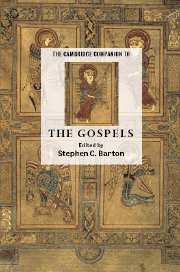Book contents
- Frontmatter
- Introduction
- Part I Approaching the gospels: context and method
- 1 What is a gospel?
- 2 The fourfold gospel
- 3 The canonical matrix of the gospels
- 4 The gospels and ‘the historical Jesus’
- 5 The gospels and the reader
- Part II The gospels as witnesses to Christ: content and interpretation
- Part III The afterlife of the gospels: impact on church and society
4 - The gospels and ‘the historical Jesus’
from Part I - Approaching the gospels: context and method
Published online by Cambridge University Press: 28 January 2007
- Frontmatter
- Introduction
- Part I Approaching the gospels: context and method
- 1 What is a gospel?
- 2 The fourfold gospel
- 3 The canonical matrix of the gospels
- 4 The gospels and ‘the historical Jesus’
- 5 The gospels and the reader
- Part II The gospels as witnesses to Christ: content and interpretation
- Part III The afterlife of the gospels: impact on church and society
Summary
No matter what their views on this subject, the phrase 'the historical Jesus' is understandable to most contemporary students of the Bible. To Martin Luther, Thomas Aquinas or John Chrysostom, however, such a phrase, rendered into their native tongues of course, would have not been immediately intelligible. For us, the phrase 'the historical Jesus' assumes that there is a gap between the gospels' portrayal of Jesus and Jesus as we come to know him in the light of various historical investigations. This is a gap that these premodern characters would not have recognized. It may be tempting to think that the difference between Luther, Aquinas, Chrysostom and us is that they had a naively literalistic understanding of the gospels, neglecting or glossing over textual puzzles which would later provide fuel for historical study of Jesus. While the adoption of such a posture towards our premodern predecessors is very common in historical Jesus studies, it simply would not be accurate. As soon as the church recognized four canonical gospels it also recognized the extraordinary diversity of these texts and the differing things they said about Jesus. Nevertheless, attempts to harmonize the four gospels into one, such as Tatian's Diatessaron, have never succeeded in replacing the four gospels in all of their differences. Further, when disputes arose, it was not normally due to one side's recognition of a diversity ignored by their opponents. The difference between Ireneaus and his Valentinian opponents, for example, was not that Irenaeus refused to recognize the diversity of the New Testament texts and the Valentinians did. The difference lay in the ways they ordered that diversity.
- Type
- Chapter
- Information
- The Cambridge Companion to the Gospels , pp. 76 - 96Publisher: Cambridge University PressPrint publication year: 2006



